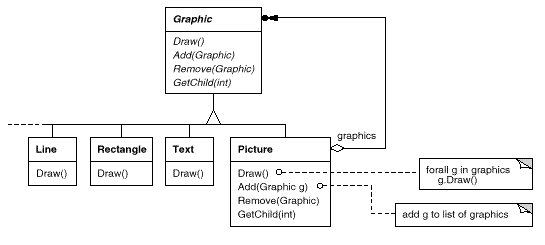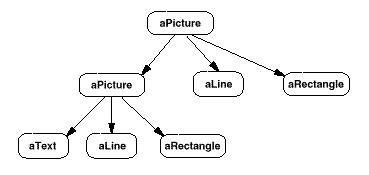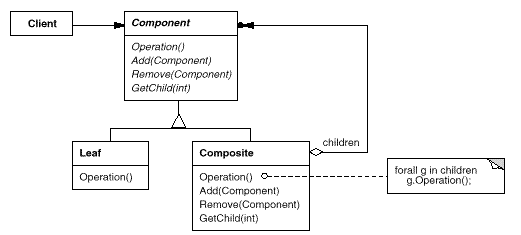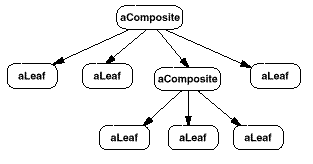 Intent
Intent Intent
IntentCompose objects into tree structures to represent part-whole hierarchies. Composite lets clients treat individual objects and compositions of objects uniformly.
 Motivation
MotivationGraphics applications like drawing editors and schematic capture systems let users build complex diagrams out of simple components. The user can group components to form larger components, which in turn can be grouped to form still larger components. A simple implementation could define classes for graphical primitives such as Text and Lines plus other classes that act as containers for these primitives.
But there's a problem with this approach: Code that uses these classes must treat primitive and container objects differently, even if most of the time the user treats them identically. Having to distinguish these objects makes the application more complex. The Composite pattern describes how to use recursive composition so that clients don't have to make this distinction.

The key to the Composite pattern is an abstract class that represents both primitives and their containers. For the graphics system, this class is Graphic. Graphic declares operations like Draw that are specific to graphical objects. It also declares operations that all composite objects share, such as operations for accessing and managing its children.
The subclasses Line, Rectangle, and Text (see preceding class diagram) define primitive graphical objects. These classes implement Draw to draw lines, rectangles, and text, respectively. Since primitive graphics have no child graphics, none of these subclasses implements child-related operations.
The Picture class defines an aggregate of Graphic objects. Picture implements Draw to call Draw on its children, and it implements child-related operations accordingly. Because the Picture interface conforms to the Graphic interface, Picture objects can compose other Pictures recursively.
The following diagram shows a typical composite object structure of recursively composed Graphic objects:

 Applicability
ApplicabilityUse the Composite pattern when
 Structure
Structure
A typical Composite object structure might look like this:

 Participants
Participants Collaborations
Collaborations Consequences
ConsequencesThe Composite pattern
 Implementation
ImplementationThere are many issues to consider when implementing the Composite pattern:
The usual place to define the parent reference is in the Component class. Leaf and Composite classes can inherit the reference and the operations that manage it.
With parent references, it's essential to maintain the invariant that all children of a composite have as their parent the composite that in turn has them as children. The easiest way to ensure this is to change a component's parent only when it's being added or removed from a composite. If this can be implemented once in the Add and Remove operations of the Composite class, then it can be inherited by all the subclasses, and the invariant will be maintained automatically.
A possible solution is for children to store multiple parents. But that can lead to ambiguities as a request propagates up the structure. The Flyweight (195) pattern shows how to rework a design to avoid storing parents altogether. It works in cases where children can avoid sending parent requests by externalizing some or all of their state.
However, this goal will sometimes conflict with the principle of class hierarchy design that says a class should only define operations that are meaningful to its subclasses. There are many operations that Component supports that don't seem to make sense for Leaf classes. How can Component provide a default implementation for them?
Sometimes a little creativity shows how an operation that would appear to make sense only for Composites can be implemented for all Components by moving it to the Component class. For example, the interface for accessing children is a fundamental part of a Composite class but not necessarily Leaf classes. But if we view a Leaf as a Component that never has children, then we can define a default operation for child access in the Component class that never returns any children. Leaf classes can use the default implementation, but Composite classes will reimplement it to return their children.
The child management operations are more troublesome and are discussed in the next item.
The decision involves a trade-off between safety and transparency:
We have emphasized transparency over safety in this pattern. If you opt for safety, then at times you may lose type information and have to convert a component into a composite. How can you do this without resorting to a type-unsafe cast?
One approach is to declare an operation Composite*
GetComposite() in the Component class. Component provides a default
operation that returns a null pointer. The Composite class redefines
this operation to return itself through the this pointer:
class Composite;
class Component {
public:
//...
virtual Composite* GetComposite() { return 0; }
};
class Composite : public Component {
public:
void Add(Component*);
// ...
virtual Composite* GetComposite() { return this; }
};
class Leaf : public Component {
// ...
};
GetComposite lets you query a component to see if it's a
composite. You can perform Add and
Remove safely on the composite it returns.
Composite* aComposite = new Composite;
Leaf* aLeaf = new Leaf;
Component* aComponent;
Composite* test;
aComponent = aComposite;
if (test = aComponent->GetComposite()) {
test->Add(new Leaf);
}
aComponent = aLeaf;
if (test = aComponent->GetComposite()) {
test->Add(new Leaf); // will not add leaf
}
Similar tests for a Composite can be done using the C++
dynamic_cast construct.
Of course, the problem here is that we don't treat all components uniformly. We have to revert to testing for different types before taking the appropriate action.
The only way to provide transparency is to define default
Add and Remove operations in Component. That
creates a new problem: There's no way to implement
Component::Add without introducing the possibility of it
failing. You could make it do nothing, but that ignores an important
consideration; that is, an attempt to add something to a leaf probably
indicates a bug. In that case, the Add operation produces
garbage. You could make it delete its argument, but that might not
be what clients expect.
Usually it's better to make Add and
Remove fail by default (perhaps by raising an
exception) if the component isn't allowed to have children or if the
argument of Remove isn't a child of the component,
respectively.
Another alternative is to change the meaning of "remove" slightly. If
the component maintains a parent reference, then we could redefine
Component::Remove to remove itself from its
parent. However, there still isn't a meaningful interpretation for a
corresponding Add.
When child ordering is an issue, you must design child access and management interfaces carefully to manage the sequence of children. The Iterator (257) pattern can guide you in this.
Changes to a component will require invalidating the caches of its parents. This works best when components know their parents. So if you're using caching, you need to define an interface for telling composites that their caches are invalid.
 Sample Code
Sample CodeEquipment such as computers and stereo components are often organized into part-whole or containment hierarchies. For example, a chassis can contain drives and planar boards, a bus can contain cards, and a cabinet can contain chassis, buses, and so forth. Such structures can be modeled naturally with the Composite pattern.
Equipment class defines an interface for all equipment in
the part-whole hierarchy.
class Equipment {
public:
virtual ~Equipment();
const char* Name() { return _name; }
virtual Watt Power();
virtual Currency NetPrice();
virtual Currency DiscountPrice();
virtual void Add(Equipment*);
virtual void Remove(Equipment*);
virtual Iterator* CreateIterator();
protected:
Equipment(const char*);
private:
const char* _name;
};
Equipment declares operations that return the
attributes of a piece of equipment, like its power consumption and
cost. Subclasses implement these operations for specific kinds of
equipment. Equipment also declares a
CreateIterator operation that returns an Iterator
(see Appendix C)
for accessing its parts. The
default implementation for this operation returns a NullIterator,
which iterates over the empty set.
Subclasses of Equipment might include Leaf classes that
represent disk drives, integrated circuits, and switches:
class FloppyDisk : public Equipment {
public:
FloppyDisk(const char*);
virtual ~FloppyDisk();
virtual Watt Power();
virtual Currency NetPrice();
virtual Currency DiscountPrice();
};
CompositeEquipment is the base class for equipment
that contains other equipment. It's also a subclass of
Equipment.
class CompositeEquipment : public Equipment {
public:
virtual ~CompositeEquipment();
virtual Watt Power();
virtual Currency NetPrice();
virtual Currency DiscountPrice();
virtual void Add(Equipment*);
virtual void Remove(Equipment*);
virtual Iterator* CreateIterator();
protected:
CompositeEquipment(const char*);
private:
List _equipment;
};
CompositeEquipment defines the operations for accessing and
managing subequipment. The operations Add and
Remove insert and delete equipment from the list of equipment
stored in the _equipment member. The operation
CreateIterator returns an iterator (specifically, an
instance of ListIterator) that will traverse this list.
A default implementation of NetPrice might use
CreateIterator to sum the net prices of the
subequipment2:
Currency CompositeEquipment::NetPrice () {
Iterator* i = CreateIterator();
Currency total = 0;
for (i->First(); !i->IsDone(); i->Next()) {
total += i->CurrentItem()->NetPrice();
}
delete i;
return total;
}
Now we can represent a computer chassis as a subclass of
CompositeEquipment called Chassis.
Chassis inherits the child-related operations from
CompositeEquipment.
class Chassis : public CompositeEquipment {
public:
Chassis(const char*);
virtual ~Chassis();
virtual Watt Power();
virtual Currency NetPrice();
virtual Currency DiscountPrice();
};
We can define other equipment containers such as
Cabinet and Bus in a similar way.
That gives us everything we need to assemble equipment into a (pretty
simple) personal computer:
Cabinet* cabinet = new Cabinet("PC Cabinet");
Chassis* chassis = new Chassis("PC Chassis");
cabinet->Add(chassis);
Bus* bus = new Bus("MCA Bus");
bus->Add(new Card("16Mbs Token Ring"));
chassis->Add(bus);
chassis->Add(new FloppyDisk("3.5in Floppy"));
cout << "The net price is " << chassis->NetPrice() << endl;
 Known Uses
Known UsesExamples of the Composite pattern can be found in almost all object-oriented systems. The original View class of Smalltalk Model/View/Controller [KP88] was a Composite, and nearly every user interface toolkit or framework has followed in its steps, including ET++ (with its VObjects [WGM88]) and InterViews (Styles [LCI+92], Graphics [VL88], and Glyphs [CL90]). It's interesting to note that the original View of Model/View/Controller had a set of subviews; in other words, View was both the Component class and the Composite class. Release 4.0 of Smalltalk-80 revised Model/View/Controller with a VisualComponent class that has subclasses View and CompositeView.
The RTL Smalltalk compiler framework [JML92] uses the Composite pattern extensively. RTLExpression is a Component class for parse trees. It has subclasses, such as BinaryExpression, that contain child RTLExpression objects. These classes define a composite structure for parse trees. RegisterTransfer is the Component class for a program's intermediate Single Static Assignment (SSA) form. Leaf subclasses of RegisterTransfer define different static assignments such as
Another subclass, RegisterTransferSet, is a Composite class for representing assignments that change several registers at once.
Another example of this pattern occurs in the financial domain, where a portfolio aggregates individual assets. You can support complex aggregations of assets by implementing a portfolio as a Composite that conforms to the interface of an individual asset [BE93].
The Command (233) pattern describes how Command objects can be composed and sequenced with a MacroCommand Composite class.
 Related Patterns
Related PatternsOften the component-parent link is used for a Chain of Responsibility (223).
Decorator (175) is often used with Composite. When decorators and composites are used together, they will usually have a common parent class. So decorators will have to support the Component interface with operations like Add, Remove, and GetChild.
Flyweight (195) lets you share components, but they can no longer refer to their parents.
Iterator (257) can be used to traverse composites.
Visitor (331) localizes operations and behavior that would otherwise be distributed across Composite and Leaf classes.
2It's easy to forget to delete the iterator once you're done with it. The Iterator pattern shows how to guard against such bugs on page 266.